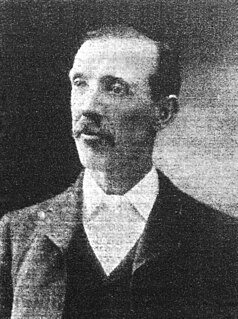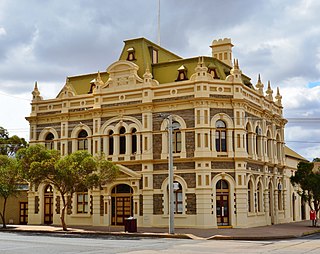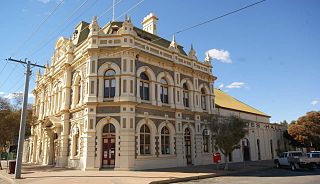
The United Mine Workers of America is a North American labor union best known for representing coal miners. Today, the Union also represents health care workers, truck drivers, manufacturing workers and public employees in the United States and Canada. Although its main focus has always been on workers and their rights, the UMW of today also advocates for better roads, schools, and universal health care. By 2014, coal mining had largely shifted to open pit mines in Wyoming, and there were only 60,000 active coal miners. The UMW was left with 35,000 members, of whom 20,000 were coal miners, chiefly in underground mines in Kentucky and West Virginia. However it was responsible for pensions and medical benefits for 40,000 retired miners, and for 50,000 spouses and dependents.

The One Big Union was an idea in the late 19th and early 20th centuries amongst trade unionists to unite the interests of workers and offer solutions to all labour problems.
The Australian labour movement began in the early 19th century and since the late 19th century has included industrial and political wings. Trade unions in Australia may be organised on the basis of craft unionism, general unionism, or industrial unionism. Almost all unions in Australia are affiliated with the Australian Council of Trade Unions (ACTU), many of which have undergone a significant process of amalgamations, especially in the late 1980s and early 1990s. The leadership and membership of unions hold and have at other times held a wide range of political views, including communist, socialist and right-wing views.
The 1890 Australian maritime dispute was an industrial dispute that began on 15 August 1890 when the Mercantile Marine Officers' Association directed its members to give 24 hours' notice to their employers after negotiations broke down with the Steamship Owners' Association of Victoria over longstanding pay and conditions claims. Industrial action quickly spread to seamen, wharf labourers, then gas stockers. Coal miners from Newcastle, Broken Hill, and even New Zealand were locked out after refusing to dig coal for non-union operated vessels. By September 1890, 28,500 workers were on strike.
The Miners' Federation of Great Britain (MFGB) was established after a meeting of local mining trade unions in Newport, Wales in 1888. The federation was formed to represent and co-ordinate the affairs of local and regional miners' unions in England, Scotland and Wales whose associations remained largely autonomous. At its peak, the federation represented nearly one million workers. It was reorganised into the National Union of Mineworkers in 1945.
The Progressive Miners of America was a coal miners' union organized in 1932 in downstate Illinois. It was formed in response to a 1932 contract proposal negotiated by United Mine Workers President John L. Lewis, which reduced wages from a previous rate of $6.10 per day to $5.00 per day.

Edward "Ed" Boyce was president of the Western Federation of Miners, a radical American labor organizer, socialist and hard rock mine owner.

The Barrier Industrial Council is the trades and labour council in Broken Hill, New South Wales, Australia, and surrounding areas. Formed in 1923 by 18 trade unions, the council has been unusually influential in local government, for a labour confederation. The BIC also owns the only newspaper based in Broken Hill, the Barrier Daily Truth.

John Henry Cann was a New South Wales politician, Treasurer, and Minister of the Crown in the cabinets of James McGowen and William Holman.
Robert Chisholm Robertson was a Scottish political activist.
The Lancashire and Cheshire Miners' Federation (LCMF) was a trade union that operated on the Lancashire Coalfield in North West England from 1881 until it became the Lancashire area of the National Union of Mineworkers in 1945.

The Women's Brigade was a labour protest organisation for women formed during the first of several strikes to occur in the mining town of Broken Hill, NSW, Australia between 1889–1920.

People have worked as coal miners for centuries, but they became increasingly important during the Industrial revolution when coal was burnt on a large scale to fuel stationery and locomotive engines and heat buildings. Owing to coal's strategic role as a primary fuel, coal miners have figured strongly in labor and political movements since that time. After the late 19th century coal miners in many countries were a frequent presence in industrial disputes with both the management and government. Coal miners' politics, while complex, have occasionally been radical, with a frequent leaning towards far-left political views. A number of far-left political movements have had the support of both coal miners themselves and their trade unions, particularly in Great Britain. In France, on the other hand, coal miners have been much more conservative. In India, Coal Miners Day is celebrated on May 4.
William Small was a Scottish trade unionist.

Broken Hill Women's Memorial is located in the Town Square of Broken Hill, New South Wales, Australia, and honours the contribution of women to the Broken Hill community. In particular, it acknowledges the work of women who supported the town's miners during long and difficult strikes and industrial disputes. Some of these women organised themselves into the Women's Brigade. Their work included picketing outside the mine, organising protest marches and rallies, and tarring and feathering non-unionised workers who tried to enter the mine during strikes.

The Monmouthshire and South Wales Coal Owners' Association (MSWCOA) was an association of mine owners in South Wales that was active between 1873 and 1955. It fought wage increases, safety regulations, unionisation and other changes that would cut into profits. It managed to link miners wages, which were based on piece-work, to the price of coal. It was involved in various labour disputes, including a lengthy strike in 1926. The coal mines became unprofitable in the 1930s and were nationalized in 1947, making the association irrelevant.
The history of trade unions in the United Kingdom covers British trade union organisation, activity, ideas, politics, and impact, from the early 19th century to the present.

The Broken Hill Trades Hall is a heritage-listed trades hall at 34 Sulphide Street, Broken Hill, City of Broken Hill, New South Wales, Australia. It was designed by Tom Jackson and built from 1898 to 1905. The property is owned by the Trades Hall Trust. It was added to the New South Wales State Heritage Register on 2 April 1999.
The Australian Coal and Shale Employees' Federation was an Australian trade union representing workers in the coal mining industry from 1913 to 1990.

Samuel Byrne was an Australian naïve painter and folk historian who visually chronicled the rise of Broken Hill, from its frontier days right through to the establishment of a modern city. Without any formal training, Byrne took to painting when he was in his seventies after retiring from a lifetime working on Broken Hill's mines. His painstakingly detailed panoramas of Broken Hill's township were discovered by Leonard French, who brought him to the attention of Sydney and Melbourne's art connoisseurs. Byrne is best known for painting his memories of subjects that held a personal fascination for him; Broken Hill's rabbit plagues, Sturt's desert peas, dust storms, industrial riots, and pioneering mining scenes. As a trade unionist and having first hand experience of the harsh mine conditions, his works are often imbued with a working-class consciousness and show a deep sensitivity to the plight of the victimised. Although the media often compared him to Grandma Moses, as James Gleeson writes, Byrne "paints in a manner that is so consistent that we are obliged to acknowledge it as a personal style."











